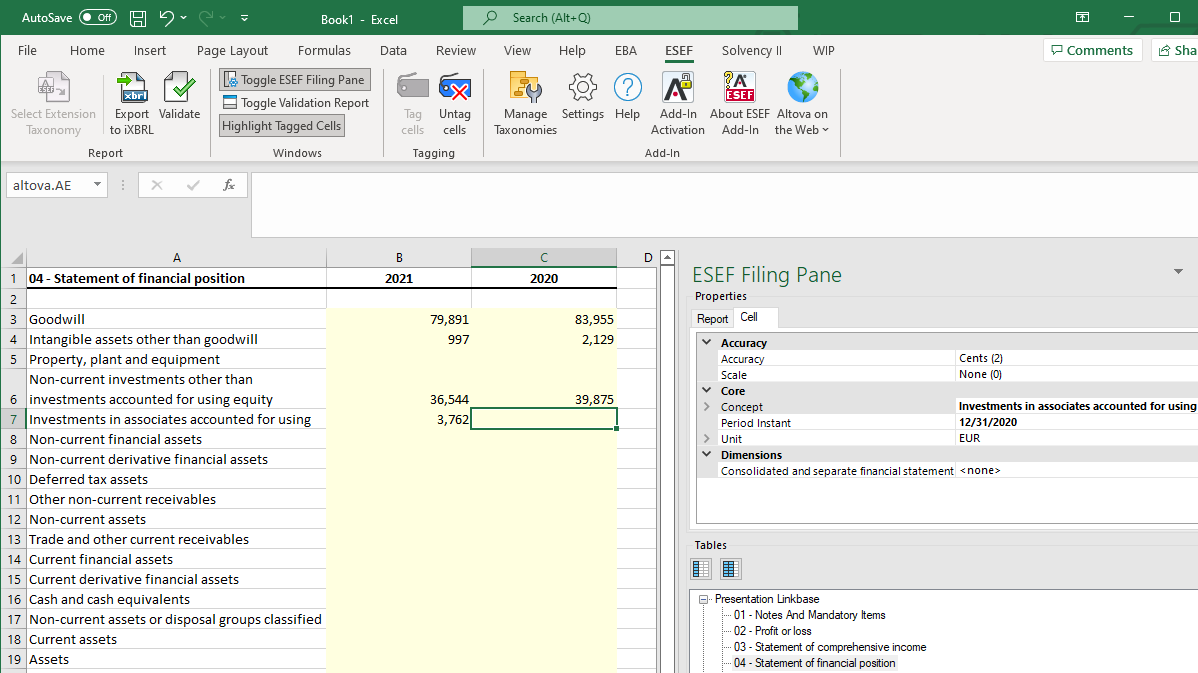
The Altova European Single Electronic Format (ESEF) XBRL Add-in for Excel shields reporting companies from the complexity of XBRL syntax.
This unique tool makes it easy for financial professionals to generate ESEF XBRL reports compliant with ESMA filing rules, all in an application where they’re already comfortable working: Excel.

The Altova European Single Electronic Format (ESEF) XBRL Add-in for Excel shields reporting companies from the complexity of XBRL syntax.
This unique tool makes it easy for financial professionals to generate ESEF XBRL reports compliant with ESMA filing rules, all in an application where they’re already comfortable working: Excel.
As of January 1, 2020, the European Securities and Markets Authority (ESMA) has mandated that companies with securities within the EU and UK submit their financial reports in ESEF, which is an iXBRL format.
ESEF (European Single Electronic Format) defines a digital financial report with guidelines defined by ESMA. By standardizing on ESEF, companies and regulatory agencies can benefit from the advantages of XBRL. These include support for data validation, improved consistency and compatibility for software processing, and simplified comparison of reported data within an organization and among multiple companies.
For filing companies, however, the challenge lies in getting backend data into a valid XBRL format according to the ESEF Taxonomy, especially since the employees recording the data are generally financial professionals.
What if you could generate valid ESEF XBRL reports directly from Excel? The Altova ESEF XBRL Add-in for Excel does exactly that, offering financial professionals an easy-to-use template using software they're already familiar with.
Building ESEF XBRL in Excel has numerous benefits:
To make viewing and managing report properties even easier, the ESEF Filing Pane lets you view and update information pertaining to document properties and tables. The Cell Documentation window displays the description of the currently selected cell or property as it’s annotated in the underling taxonomy, so you can understand exactly what to enter.
At any time during report creation, and especially before exporting the report to iXBRL, you can validate data entered in the Excel template and filing pane. Validation ensures that the XBRL data being filed conforms to the XBRL specification.
If a validation error is detected, the Validation Report window displays a message about the error and a hyperlink to the cell where the error occurred for easy troubleshooting.
ESEF reports are based on company-specific extensions to a base ESEF XBRL taxonomy. Prior to tagging ESEF reports for submission, companies must create an extension taxonomy. The Altova ESEF XBRL add-in for Excel includes a Taxonomy Editor for visually editing your organization's extension taxonomy or creating a new extension from scratch.
After clicking the Taxonomy Editor button in the ESEF tab of the Excel ribbon, you can either open an existing extension taxonomy or create a new one. The extension taxonomy is defined in a visual way that shields the user from the underlying XBRL syntax.
Core details are easily specified, and presentation and calculation linkbase tabs let the user drag and drop to add tables.
The ESEF add-in will save the extension taxonomy as a taxonomy package, and you can proceed with creating ESEF XBRL reports directly in Excel.
This easy extension taxonomy editor makes the Altova ESEF add-in for Excel the only tool companies need to create valid ESEF XBRL reports in an easy, user-friendly way.
The ESEF XBRL Add-in supports the base ESEF XBRL Taxonomy from Version 2017 on. The list of supported XBRL taxonomies is periodically updated to include the latest versions, independently of Altova add-in releases.
To view, install, update, and uninstall ESEF taxonomy versions, you can use the Altova XBRL Taxonomy Manager by selecting Manage Taxonomies in the Excel ribbon.
View a list of supported taxonomy versions and entry points.
It's easy to get started with the Altova ESEF XBRL add-in for Excel. Simply download the software and install it to begin your free, 30-day trial.
You can use Excel, but not by itself. Altova’s ESEF XBRL add-in for Excel transforms Excel into a compliant ESEF report. It allows you to import your financials and then tag them with the required XBRL elements. Then, it outputs fully compliant XHTML/iXBRL files. Once you install the software, it becomes available directly in the Excel ribbon so you can work in a familiar environment without being exposed to the complicated XBRL syntax.
Yes. Using the visual taxonomy editor in the Altova ESEF XBRL add-in you can create or edit your company's extension taxonomy in a straightforward way. Then, you can create an ESEF XBRL based on that taxonomy in the same Excel environment.
ESEF reporting can seem complex at first, but the right tools make it much easier. The easiest way to create an ESEF-compliant report is with a solution designed for XBRL reporting. One example is the Altova ESEF XBRL add-in for Excel. It lets you:
- Enter your financial data in a user-friendly template
- Tag each item with the correct XBRL concepts using drop-down menus
- Create extension elements if your disclosures don’t match the ESMA taxonomy
- Validate your report
- Automatically generate the required XHTML/iXBRL output





